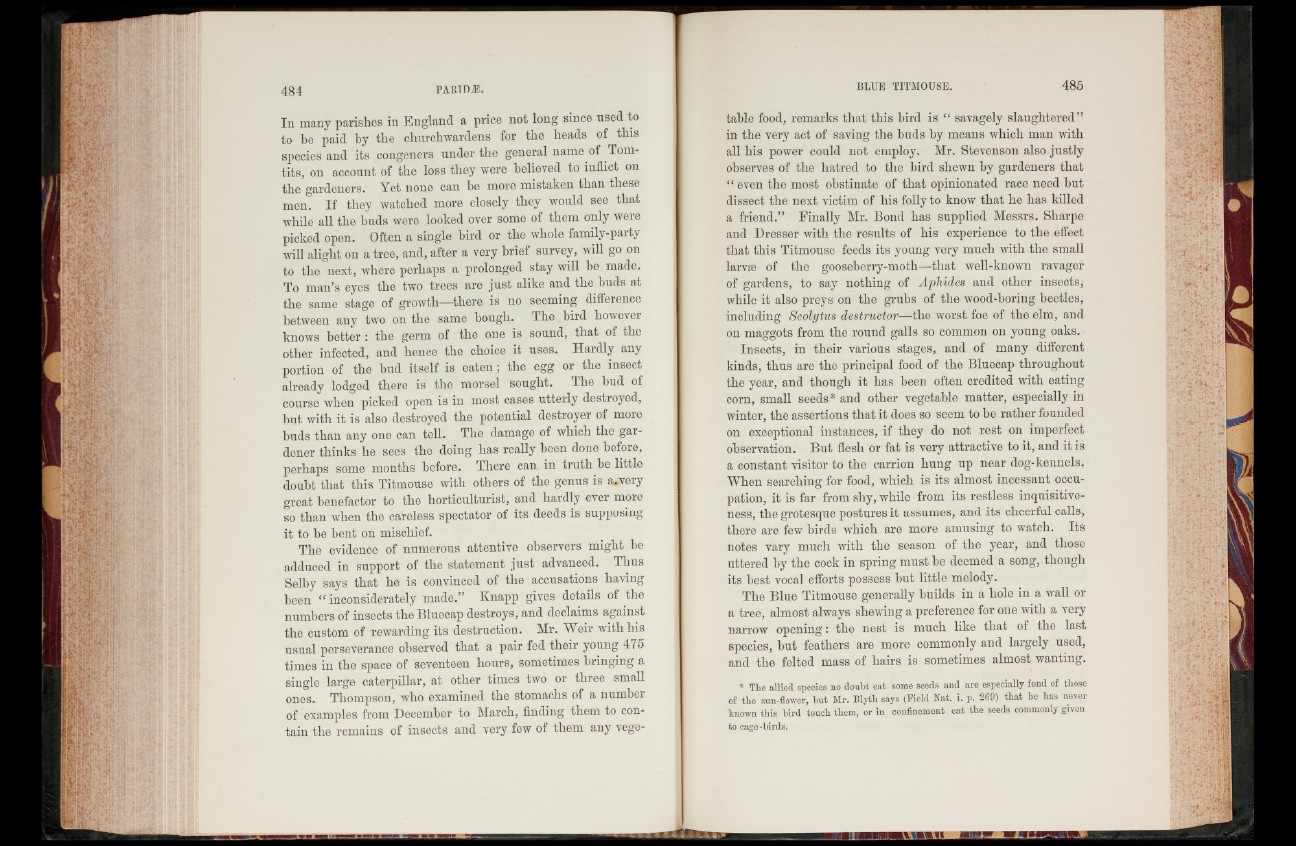
In many parishes in England a price not long since used to
to be paid by the churchwardens for the heads of this
species and its congeners under the general name oi Tomtits,
on account of the loss they were believed to inflict on
the gardeners. Yet none can be more mistaken than these
men. If they watched more closely they would see that
while all the buds were looked over some of them only were
picked open. Often a single bird or the whole family-party
will alight on a tree, and, after a very brief survey, will go on
to the next, where perhaps a prolonged stay will be made.
To man’s eyes the two trees are just alike and the buds at
the same stage of growth—there is no seeming difference
between any two on the same bough. The bird however
knows better : the germ of the one is sound, that of the
other infected, and hence the choice it uses. Hardly any
portion of the bud itself is eaten; the egg or the insect
already lodged there is the morsel sought. The bud of
course when picked open is in most cases utterly destroyed,
but with it is also destroyed the potential destroyer of more
buds than any one can tell. The damage of which the gardener
thinks he sees the doing has really been done before,
perhaps some months before. There can in truth be little
doubt that this Titmouse with others of the genus is a.very
great benefactor to the horticulturist, and hardly ever more
so than when the careless spectator of its deeds is supposing
it to be bent on mischief.
The evidence of numerous attentive observers might be
adduced in support of the statement ju st advanced. Ih u s
Selby says that he is convinced of the accusations having
been “ inconsiderately made.” Knapp gives details of the
numbers of insects the Bluecap destroys, and declaims against
the custom of rewarding its destruction. Mr. Weir with his
usual perseverance observed that a pair fed their young 475
times in the space of seventeen hours, sometimes bringing a
single large caterpillar, at other times two or three small
ones. Thompson, who examined the stomachs of a number
of examples from December to March, finding them to contain
the remains of insects and very few of them any vegetable
food, remarks that this bird is “ savagely slaughtered”
in the very act of saving the buds by means which man with
all his power could not employ. Mr. Stevenson also justly
observes of the hatred to the bird shewn by gardeners that
“ even the most obstinate of that opinionated race need but
dissect the next victim of his folly to know that he has killed
a friend.” Finally Mr. Bond has supplied Messrs. Sharpe
and Dresser with the results of his experience to the effect
that this Titmouse feeds its young very much with the small
larvse of the gooseberry-moth—that well-known ravager
of gardens, to say nothing of Aphides and other insects,
while it also preys on the grubs of the wood-boring beetles,
including Scolytus destructor—the worst foe of the elm, and
on maggots from the round galls so common on young oaks.
Insects, in their various stages, and of many different
kinds, thus are the principal food of the Bluecap throughout
the year, and though it has been often credited with eating
corn, small seeds* and other vegetable matter, especially in
winter, the assertions that it does so seem to be rather founded
on exceptional instances, if they do not rest on imperfect
observation. But flesh or fat is very attractive to it, and it is
a constant visitor to the carrion hung up near dog-kennels.
When searching for food, which is its almost incessant occupation,
it is far from shy, while from its restless inquisitiveness,
the grotesque postures it assumes, and its cheerful calls,
there are few birds which are more amusing to watch. Its
notes vary much with the season of the year, and those
uttered by the cock in spring m ust be deemed a song, though
its best vocal efforts possess but little melody.
The Blue Titmouse generally builds in a hole in a wall or
a tree, almost always shewing a preference for one with a very
narrow opening: the nest is much like that of the last
species, but feathers are more commonly and largely used,
and the felted mass of hairs is sometimes almost wanting.
* The allied species no doubt eat some seeds and are especially fond of those
of the sun-flower, but Mr. Blyth says (Field Nat. i. p. 269) that he has never
known this bird touch them, or in confinement eat the seeds commonly given